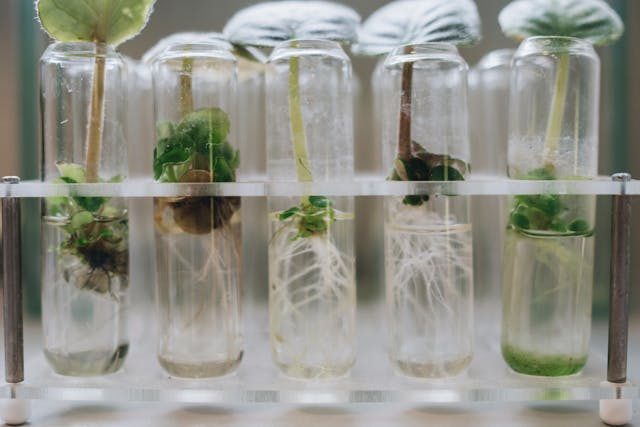Plant propagation is a rewarding and cost-effective way to expand your garden or indoor plant collection. Among various methods, propagating plants from cuttings stands out as a popular choice due to its simplicity and high success rate. This guide will walk you through the process, covering everything from selecting the right plants to caring for your new cuttings.
Understanding Plant Propagation
Plant propagation involves creating new plants from existing ones using methods like seeds, division, layering, or cuttings. Propagating from cuttings is particularly popular because it allows you to replicate the exact characteristics of the parent plant, ensuring consistency in traits like flower color, growth habit, and disease resistance.
Why Propagate Plants from Cuttings?
- Preserve the genetic makeup of the parent plant.
- Quick results compared to growing from seeds.
- Cheap and sustainable way to expand your plant collection.
- Share plants with friends and family.
Choosing the Right Plants for Propagation
Not all plants are suitable for propagation from cuttings. Some species are more conducive to this method than others. Here are some popular plants that propagate well from cuttings:
Materials Needed for Plant Propagation
To get started with plant propagation, you’ll need a few basic materials:
- Healthy parent plant with suitable stems or leaves for cuttings.
- Sharp, clean cutting tool (pruning knife, scissors, or pruning shears).
- Rooting hormone powder or liquid (optional but recommended).
- Small pots or propagation trays with drainage holes.
- Well-draining potting mix specifically designed for cuttings.
- Water spray bottle for maintaining humidity.
- Clear plastic bags or cloches to create a mini-greenhouse effect.
- Warm, bright location with indirect sunlight.
Step-by-Step Guide to Propagating Plants from Cuttings
1. Selecting and Preparing Cuttings
The success of your propagation depends largely on the quality of your cuttings. Here’s how to select and prepare them:
- Choose healthy, disease-free stems with plenty of leaves.
- For stem cuttings, select sections with at least two nodes (the joint where a leaf meets the stem).
- Cut just above a node using a sharp, clean tool to minimize damage and prevent infection.
- Remove lower leaves to prevent them from rotting in water or soil.
- Trim excess leaves to reduce transpiration and stress on the cutting.
2. Applying Rooting Hormone
Rooting hormone can significantly increase the chances of successful propagation by stimulating root growth. Here’s how to use it:
- Dip the cut end of the stem into the rooting hormone powder or liquid, tapping off any excess.
- For woody stems, you may need to leave the cutting in the hormone solution for a few hours or overnight.
3. Planting the Cutting
Once your cutting is prepared and treated with rooting hormone, it’s time to plant it:
- Firm the potting mix in the pot to create a stable base.
- Make a small hole in the soil with a pencil or dibber.
- Gently place the cutting in the hole, ensuring the node is buried in the soil.
- Firm the soil around the cutting to secure it in place.
- Water gently to settle the soil and provide enough moisture.
4. Providing the Right Conditions
Creating the right environment is crucial for the cutting to develop roots and grow:
- Place the pot in a warm, bright location but out of direct sunlight to avoid overheating.
- Maintain high humidity by covering the pot with a clear plastic bag or cloche.
- Check the soil daily to ensure it remains moist but not waterlogged.
- After 1-3 weeks, you’ll start to see new growth, indicating successful rooting.
Common Challenges and Solutions
While propagating plants from cuttings is relatively straightforward, there are common challenges you might encounter:
- Root Rot: Caused by overwatering. Solution: Ensure the potting mix is well-draining and avoid excessive watering.
- Leaf Drop: Caused by stress or lack of humidity. Solution: Maintain high humidity and ensure the cutting is in a warm, bright location.
- Pests: Aphids, spider mites, and other pests can infest weak cuttings. Solution: Inspect regularly and treat with insecticidal soap if necessary.
Practical Takeaways and Actionable Insights
Now that you’ve learned the basics of plant propagation from cuttings, here are some practical tips to help you get started:
- Start with easy-to-propagate plants like pothos or snake plants to build your confidence.
- Always use clean tools and materials to prevent the spread of disease.
- Keep a propagation journal to track the progress of your cuttings and refine your technique.
- Experiment with different types of cuttings (stem, leaf, root) to see what works best for you.
FAQs
- What is the best time of year to propagate plants from cuttings?
- The best time to propagate plants from cuttings is during the growing season when the plant is actively producing new growth. For most plants, this is in the spring or early summer.
- Can I propagate any plant from cuttings?
- Not all plants can be propagated from cuttings, but many popular houseplants and garden plants can. Some plants, like cacti and succulents, are better propagated from leaf or stem cuttings, while others may require division or layering.
- How long does it take for cuttings to root?
- The rooting time varies depending on the type of plant and environmental conditions. On average, it can take anywhere from 1 to 6 weeks for cuttings to develop roots.
- Do I need rooting hormone to propagate plants from cuttings?
- Rooting hormone is not strictly necessary, but it can significantly increase the chances of successful propagation by stimulating root growth and reducing the risk of infection.
- Can I propagate plants from cuttings in water?
- Yes, some plants like pothos and philodendron can be propagated in water. Simply place the cutting in a glass of water and wait for roots to develop before transferring it to soil.
- How often should I water plant cuttings?
- Water cuttings gently but thoroughly after planting, and keep the soil consistently moist but not waterlogged. Avoid letting the soil dry out completely, as this can stress the cutting.
- What are the common mistakes to avoid when propagating plants from cuttings?
- Common mistakes include overwatering, using poor quality cuttings, and not providing enough light or warmth. Make sure to use clean tools, well-draining soil, and maintain the right environmental conditions.
- Can I propagate plants from cuttings indoors?
- Yes, many plants can be propagated from cuttings indoors. Ensure your cuttings have access to bright, indirect light and maintain a warm, humid environment for optimal rooting.
Conclusion
Propagating plants from cuttings is a simple yet effective way to share plants with friends, expand your garden, or start new indoor plants. By following the steps outlined in this guide, you can successfully propagate a wide variety of plants. Remember to choose healthy cuttings, provide the right conditions, and be patient as your new plants develop roots and grow. Happy propagating!
We hope this guide has inspired you to give plant propagation a try. Share your experiences, tips, and questions in the comments below. Don’t forget to explore more gardening tips and tricks on our blog!
Auto Amazon Links: No products found.
Perfect Plants Christmas Tree Saver 8oz. | Easy Use Xmas Tree Preserver Food | Have Healthy Green Christmas Trees All Holiday Season
$9.97 (as of November 25, 2025 23:26 GMT +00:00 - More info- Product prices and availability are accurate as of the date/time indicated and are subject to change. Any price and availability information displayed on [relevant Amazon Site(s), as applicable] at the time of purchase will apply to the purchase of this product.
Wilt-Pruf® Christmas Tree/Cutting Preserver Spray |Preserves Christmas Trees, Wreaths, Garlands, Cuttings and Carved Pumpkins | Reduces Needle Drop | Keeps Cut Trees Fresh Longer | Natural (32 oz)
$21.99 (as of November 25, 2025 23:26 GMT +00:00 - More info- Product prices and availability are accurate as of the date/time indicated and are subject to change. Any price and availability information displayed on [relevant Amazon Site(s), as applicable] at the time of purchase will apply to the purchase of this product.
Christmas Tree Watering Funnel – 39 Inch Adjustable 3-Section Design, Reusable & Spill-Free, Easy Watering for Real Christmas Trees
$10.70 (as of November 25, 2025 23:26 GMT +00:00 - More info- Product prices and availability are accurate as of the date/time indicated and are subject to change. Any price and availability information displayed on [relevant Amazon Site(s), as applicable] at the time of purchase will apply to the purchase of this product.
HoHoHoH2o Automatic Christmas Tree Watering System Device, Santa’s Tree Helper Keeps Your Christmas Tree Healthy and Fresh, Refillable 2.5 gallons Capacity Box - Silver/Festive
$99.95 (as of November 25, 2025 23:26 GMT +00:00 - More info- Product prices and availability are accurate as of the date/time indicated and are subject to change. Any price and availability information displayed on [relevant Amazon Site(s), as applicable] at the time of purchase will apply to the purchase of this product.
IPOOLTENG Christmas Tree Watering Funnel 3 Tube 1 Funnels 40 Inch - 3 Section Plastic Christmas Tree Funnel Waterer, Long Funnels for Watering Trees, No More Bending to Water
$13.59 (as of November 25, 2025 23:26 GMT +00:00 - More info- Product prices and availability are accurate as of the date/time indicated and are subject to change. Any price and availability information displayed on [relevant Amazon Site(s), as applicable] at the time of purchase will apply to the purchase of this product.
ThermoPro TP16 Large LCD Digital Cooking Food Meat Thermometer for Smoker Oven Kitchen BBQ Grill Thermometer Clock Timer with Stainless Steel Temperature Probe
$17.99 (as of November 26, 2025 14:50 GMT +00:00 - More info- Product prices and availability are accurate as of the date/time indicated and are subject to change. Any price and availability information displayed on [relevant Amazon Site(s), as applicable] at the time of purchase will apply to the purchase of this product.
Zevo Flying Insect Trap Official Refill Cartridges - Fits Both Zevo Trap & MAX Indoor Fly Trap - Authentic Trap+Lock Technology to Catch Gnats, House & Fruit Flys (4 Official Refill Cartridges)
$13.47 (as of November 26, 2025 14:50 GMT +00:00 - More info- Product prices and availability are accurate as of the date/time indicated and are subject to change. Any price and availability information displayed on [relevant Amazon Site(s), as applicable] at the time of purchase will apply to the purchase of this product.
Victor Mouse Traps M150-12, Metal Pedal, Sustainably Sourced FSC Wood, Wooden Mouse Traps, 12 Metal Pedal Traps
$9.79 (as of November 26, 2025 14:50 GMT +00:00 - More info- Product prices and availability are accurate as of the date/time indicated and are subject to change. Any price and availability information displayed on [relevant Amazon Site(s), as applicable] at the time of purchase will apply to the purchase of this product.
Zevo Flying Insect Trap & 3 Refill Cartridges - Plug in Fly Trap & Indoor Bug Catcher for Gnats, House & Fruit Flies - Blue & UV Light Technology, Mess-Free Alternative to Bug Zapper
$25.96 (as of November 26, 2025 14:50 GMT +00:00 - More info- Product prices and availability are accurate as of the date/time indicated and are subject to change. Any price and availability information displayed on [relevant Amazon Site(s), as applicable] at the time of purchase will apply to the purchase of this product.
TERRO Ant Killer Bait Stations T300B - Liquid Bait to Eliminate Ants - Bait System - 12 Count Stations for Effective Indoor Ant Control
$10.86 (as of November 26, 2025 14:50 GMT +00:00 - More info- Product prices and availability are accurate as of the date/time indicated and are subject to change. Any price and availability information displayed on [relevant Amazon Site(s), as applicable] at the time of purchase will apply to the purchase of this product.











